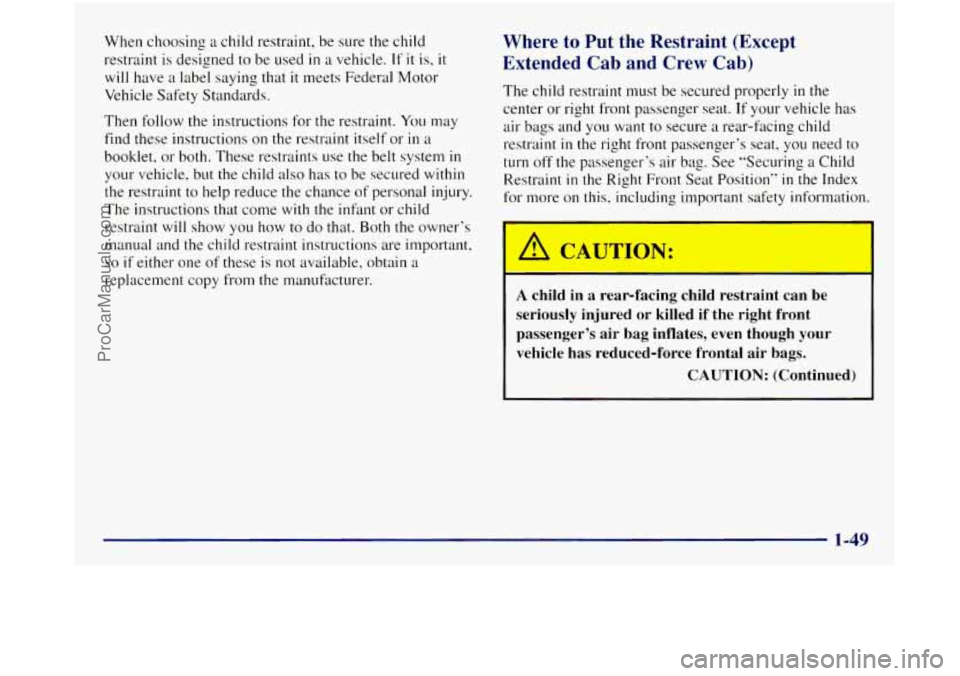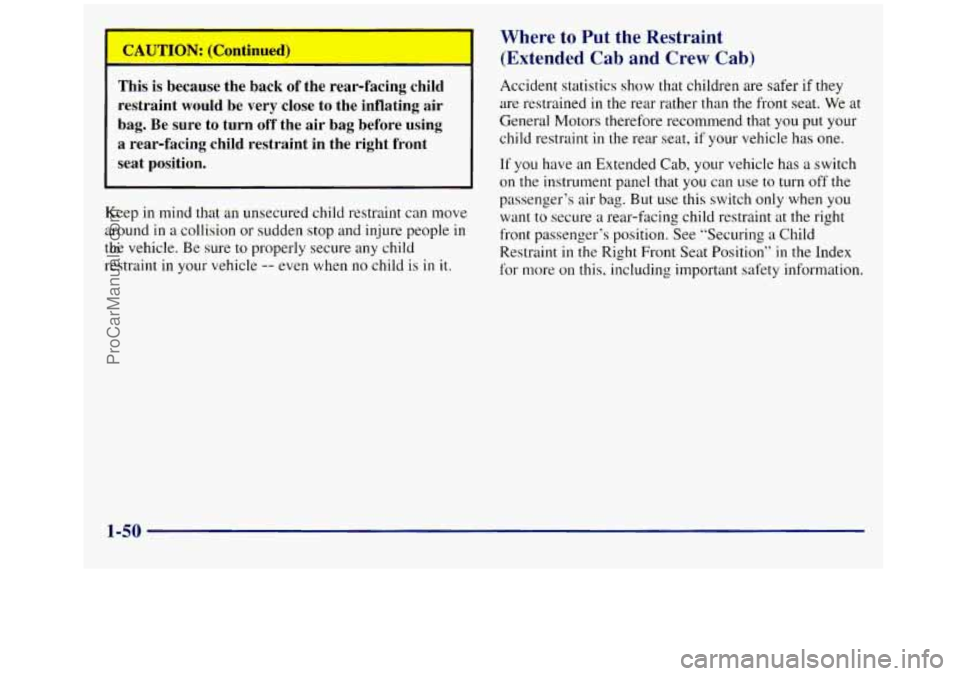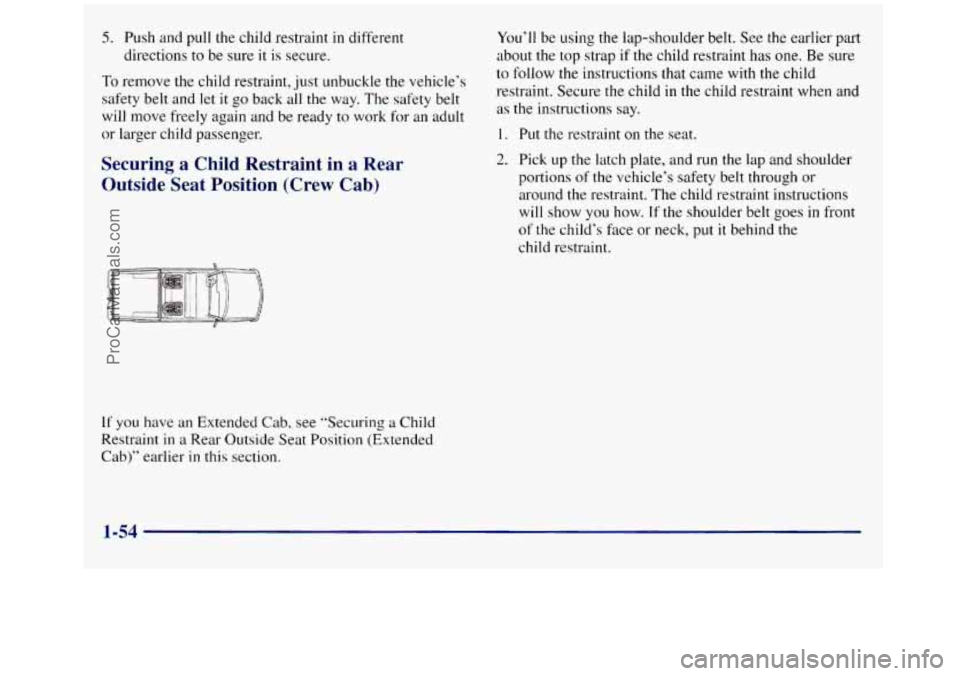Page 57 of 452
Child Restraints
Every time infants and young children ride in
vehicles, they should have protection provided by
appropriate restraints.
Q.’ What are the different types of add-on
child restraints?
A: Add-on child restraints are available in four basic
types. When selecting a child restraint, take into
consideration not
only the child’s weight and size,
but also whether or not the restraint will be
compatible
with the motor vehicle in which it will
be used.
An
inhnt car bed (A) is a special bed made for use
in a motor vehicle. It’s an infmt restraint system
designed to restrain
or position a child on a
continuous flat surface. With an
infmt car bed,
make sure that the infant’s head rests toward the
center of the vehicle.
1-45
ProCarManuals.com
Page 59 of 452
A forward-facing child restraint (C-E) positions a
child upright to fxe folwa-d in the vehicle. These
forward-facing restraints
a-e designed to help protect
children
who are from 20 to 40 Ibs. (9 to 18 kg) and
about
26 to 40 inches (66 to 102 cm) in height, or up
to around four years of age. One type, a convertible
restraint, is designed to be used either
as a rear-facing
infant seat or
a forwa-d-facing child seat.
1-47
ProCarManuals.com
Page 61 of 452

When choosing a child restraint, be sure the child
restraint is designed to be used
in a vehicle. If it is, it
will have a label saying that it meets Federal Motor
Vehicle Safety Standards.
Then follow
the instructions for the restraint. You may
find these instructions on the restraint itself or
in a
booklet, or both. These restraints use the belt system in
your vehicle, but the child also has to be secured within
the restraint to help reduce the chance of personal injury.
The instructions that come with the infant or child
restraint will show you how
to do that. Both the owner’s
manual and the child restraint instructions are important,
so if either one of these is not available, obtain a
replacement copy from the manufacturer.
Where to Put the Restraint (Except
Extended Cab and Crew Cab)
The child restraint must be secured properly in the
center or right front passenger seat.
If your vehicle has
air bags and you want
to secure a rear-facing child
restraint
in the right front passenger‘s seat, you need to
turn
off the passenger’s air bag. See “Securing a Child
Restraint
in the Right Front Seat Position” in the Index
for more on this, including important safety information
p, CAUTION:
A child in a rear-facing child restraint can be
seriously injured or killed if the right front
passenger’s air
bag inflates, even though your
vehicle has reduced-force frontal air bags.
CAUTION: (Continued)
1-49
ProCarManuals.com
Page 62 of 452

This is because the back of the rear-facing child
restraint would be very close to the inflating air
bag. Be
sure to turn off the air bag before using
a rear-facing child restraint in the right front
seat position.
Keep in mind that an unsecured child restraint can move
around
in a collision or sudden stop and injure people in
the vehicle. Be sure to properly secure any child
restraint in your vehicle
-- even when no child is in it.
Where to Put the Restraint
(Extended Cab and Crew Cab)
Accident statistics show that children are safer if they
are restrained
in the rear rather than the front seat. We at
General Motors therefore recommend that you put your
child restraint in the rear seat, if
your vehicle has one.
If you have an Extended Cab, your vehicle has a switch
on the instrument panel that you can
use to turn off the
passenger’s air bag. But use this switch only when you
want to secure
a rear-facing child restraint at the right
front passenger’s position. See ”Securing
a Child
Restraint
in the Right Front Seat Position” in the Index
for more on this, including important safety information
1-50
ProCarManuals.com
Page 63 of 452
Top Strap
A child in a rearfacing child restraint can be
seriously injured or killed
if the right front
passenger’s
air bag inflates, even though your
vehicle has reduced-force frontal
air bags. This is
because the back of the rearfacing child restraint
would be very close to the inflating
air bag. Be sure
to turn
off the air bag before using a rear-facing
child restraint
in the right front seat position.
Wherever you install it, be sure to secure the child
restraint properly.
Keep in mind that an unsecured child restraint can move
around in a collision or sudden stop and injure people in
the vehicle. Be sure to properly secure any child
restraint in your vehicle
-- even when no child is in it. If
your child restraint has a top strap, it should be
anchored. If you need to have an anchor installed, you
can ask your
GM dealer to put it in for you. If you want
to install an anchor yourself, your dealer can tell you
how to do it.
1-51
ProCarManuals.com
Page 64 of 452
Securing a Child Restraint in a Rear
Outside Seat Position (Extended
Cab)
If you have a Crew Cab, see “Securing a Child Restraint in a
Rear Outside Seat Position (Crew Cab)” later in
this section.
You’ll be using the lap-shoulder belt. See the earlier part
about the top strap if the child restraint has one. Be sure
to follow the instructions that came with the child
restraint. Secure the child in the child restraint when and
as the instructions say.
1. Put the restraint on the seat.
2. Pick up the latch plate, and run the lap and shoulder
portions of the vehicle’s safety belt through or
around the restraint. The child restraint instructions
will show you how. Tilt the latch plate
to adjust the belt if needed. If the
shoulder belt goes in front
of the child’s face or neck,
put it behind the child restraint.
1-52
ProCarManuals.com
Page 65 of 452
3. Buckle the belt. Make sure the release button is
positioned
so you would be able to unbuckle the
safety belt quickly
if you ever had to.
4. To tighten the belt., pull up on the shoulder belt while
you push down on the child restraint.
If you're using
a forward-facing child restraint, you may find it
helpful to use your knee to push down on the child
restraint as you tighten the belt.
Make sure the buckle end of the belt is pulled out all
the way.
1-53
ProCarManuals.com
Page 66 of 452

5. Push and pull the child restraint in different
directions to be sure it
is secure.
To remove the child restraint, just unbuckle the vehicle’s
safety belt and let
it go back all the way. The safety belt
will move freely again and be ready to work for an adult
or larger child passenger.
Securing a Child Restraint in a Rear
Outside Seat Position (Crew Cab)
If you have an Extended Cab, see ”Securing a Child
Restraint
in a Rear Outside Seat Position (Extended
Cab)” earlier
in this section. You’ll be
using the lap-shoulder belt. See the earlier
part
about the top strap if the child restraint has one. Be sure
to follow the instructions
that came with the child
restraint. Secure the child
in the child restraint when and
as the instructions say.
1. Put the restraint on the seat.
2. Pick up the latch plate, and run the lap and shoulder
portions
of the vehicle’s safety belt through or
around the restraint. The child restraint instructions
will show you how. If the shoulder belt goes in front
of the child’s face or neck, put it behind the
child restraint.
1-54
ProCarManuals.com